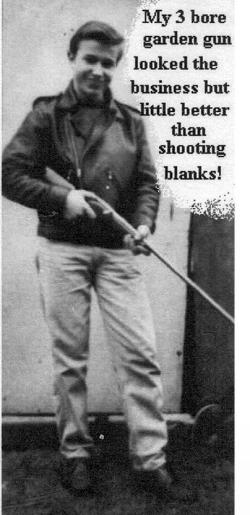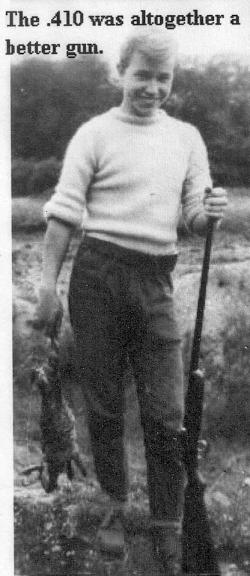THE PERIOD FROM 1950 TO ABOUT1965

Cordite
Chapter 14. Shotguns.
- Tony
One fateful day we met a boy on the common with a 16bore double barrelled shotgun. It was very worn with one barrel split open by a burst and bound with black sticky cloth insulating tape. The hammer that connected with the sound barrel was swathed in rubber bands to give it a bit more power to drive the firing pin home. I was instantly attracted to its 'bigness'! I loved the matching of wood to metal on this relic which in its day had been a fine gun. I loved the graceful English stock that culminated in what seemed like a mechanical mass of hammers levers and engraving, tapering once more to slender thirty two inch barrels. When it spoke, the tin that we were denting with our airguns leapt ten feet into the air and came to rest perforated and distorted beyond recognition.

From that day on our airguns did not have quite the same lustre. They seemed puny in comparison with the shotgun. We scorned the fact that one cartridge cost the same as a hundred of our pellets. We argued the fact that one bang and all the game for miles around would run away and hide. We went on our way in silence plinking at odd bits and pieces but in all our minds was that massive, magnificent report and the smoking earth where once had sat our bean can.
One at a time the shotguns appeared. These were mainly .410's but one or two boys were beguiled into buying 9mm or 3bore garden guns. These little guns looked the part with their bolt actions and chromium plated cartridges, but when it came to performance it seemed little difference to firing blanks!

Now the .410 was altogether a better weapon. It was a cartridge that appealed to our sense of proportion, not as fat and bulky as a 12bore, it looked good in a cartridge belt. In summer we looked like Mexican bandits stripped to the waist with home made bandoliers of cartridges slung across our shoulders.
In Uxbridge market was our trading post. At the back of the 'Pet Supplies' was a rack of ancient second hand guns. Each gun was of dubious condition and carried an extortionate price tag. The fierce looking trader had one redeeming feature; he asked no questions about licenses or age! He also took part exchange, usually a fine airgun for a relic. Some guns costing three weeks wages had pits in the barrel forming rings and were well out of proof, but this meant little to us.
I had my eye on my first shotgun. It was an 1898 vintage Martini carbine converted from .303 to .410. I think the converting had consisted of just deepening the breech so that a .410 cartridge would fit in! I later found that most of the barrel still had rifling in!
I was not prepared to swap my nice well cared for BSA Cadet Major for it as the rogue wanted some money as well. Instead I paid his price and spent that evening tightening up screws and removing all traces of the colonial wars.

As can be imagined with such a bore the pattern was wide and patchy. It threw most of the shot to one side, not always the same side! But I liked the way it looked, rugged and business like. I found it impossible to hunt with unless I stalked the quarry to within fifteen paces. The expense was another disadvantage. Whereas we would be shooting virtually every minute with airguns at twigs, tins, into water to hear the plop, at rocks to hear the ricochet, a morning's shotgunning may consist of just two shots. I would happily go out with perhaps three cartridges with the .410 because I knew that I wouldn't shoot unless I could make the shot count.
After a lot of wasted shots, I decided that the Martini had to go. I managed to find a buyer, a lad that had just started work and had a wage packet burning a hole in his pocket. He said he had a large wooden chest of .303 ammunition that his father had not returned from the Home Guard after the war. He had some idea of shooting it through the old Martini.
- Tony Sheppard